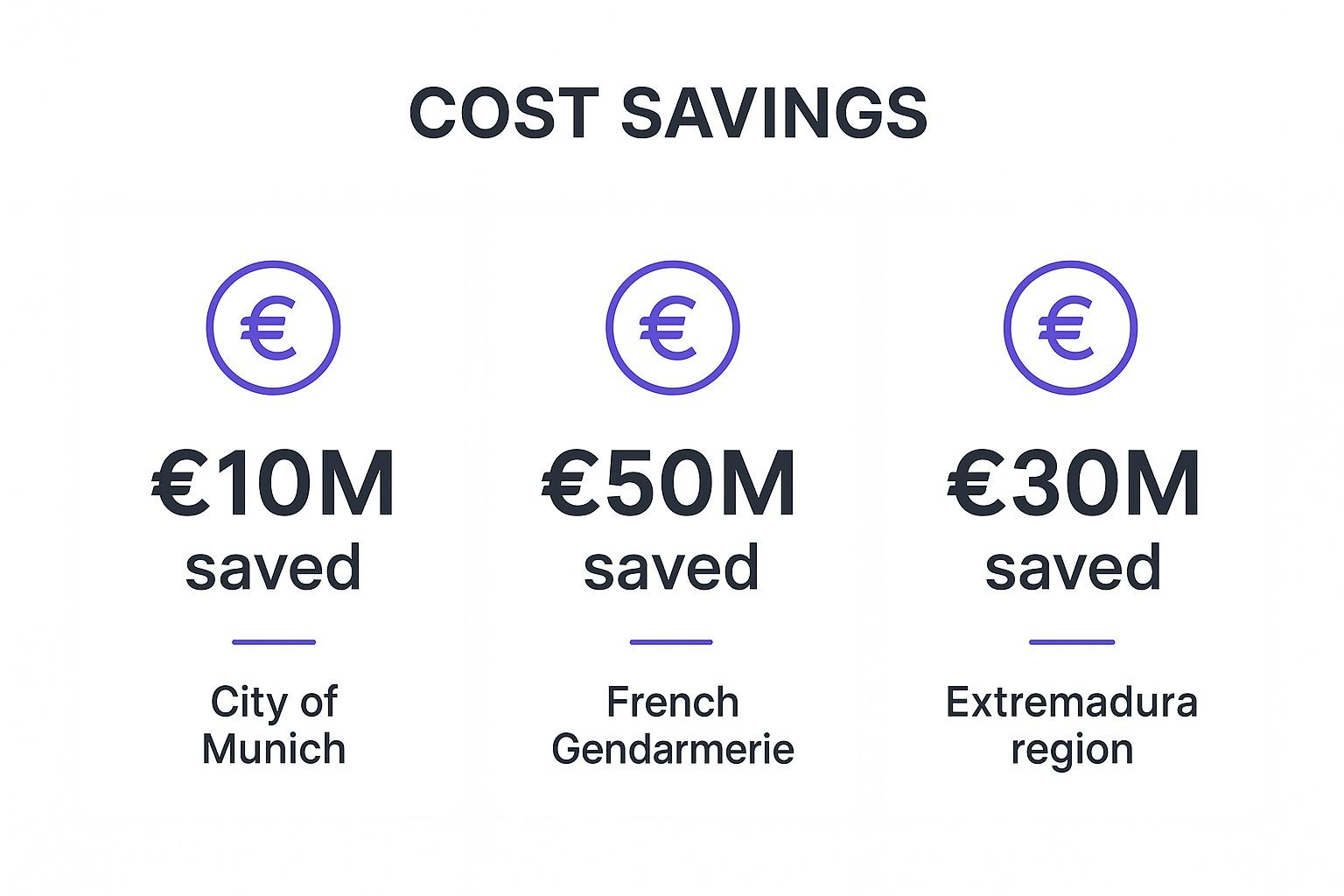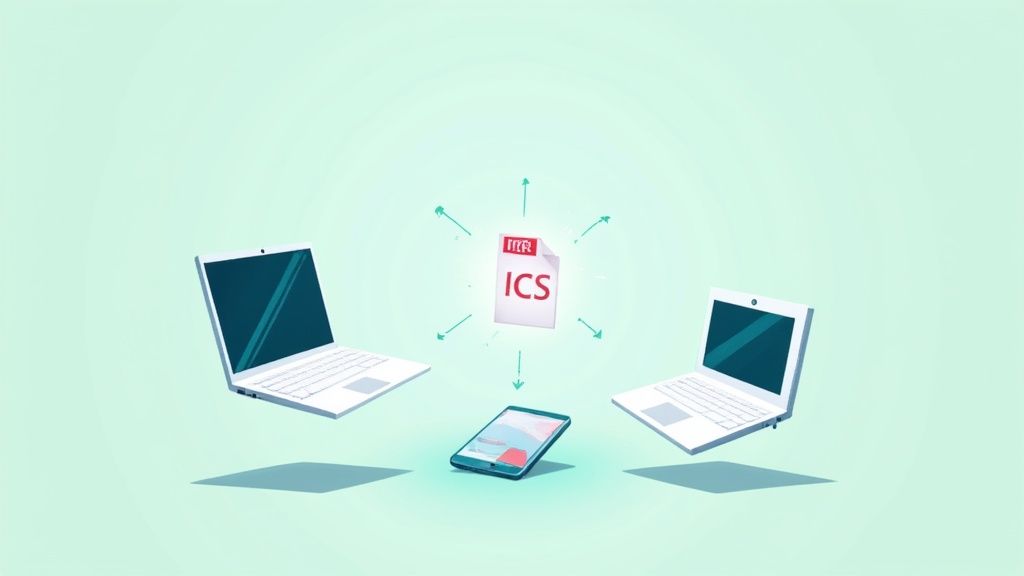In a world of skyrocketing subscription costs and restrictive software licenses, smart marketers are turning to a powerful, flexible, and cost-effective alternative: open source software (OSS). The core open source software benefits, however, extend far beyond just saving money on your budget. From unparalleled security and customization to accelerated innovation, OSS offers a strategic advantage that can redefine your marketing and event management capabilities. For marketers building their digital presence, understanding the various software components of a marketing stack, like the different Content Management Systems, is essential for success.
This article explores the seven key benefits of integrating OSS into your operations. We will provide practical examples and actionable insights to help you understand how embracing open source principles can future-proof your tech stack. We'll examine how this approach enhances everything from security to reliability, giving you complete control over your tools. Along the way, we'll touch on how our service, Add to Calendar PRO, leverages its open source roots to provide a transparent and powerful event marketing platform. Let's dive into why OSS is more than just code-it's a competitive edge.
1. Cost-effectiveness and Budget Efficiency
One of the most significant and immediate open source software benefits is the profound impact on your budget. Unlike proprietary software that often requires substantial upfront licensing fees and ongoing subscription costs per user, open source alternatives are typically free to acquire. This model fundamentally shifts how organizations, especially in the event marketing space, can allocate their financial resources.
Instead of dedicating a large portion of your budget to software licenses, you can redirect those funds toward strategic initiatives that directly enhance attendee experience or expand marketing reach. This could mean investing in better venue technology, more sophisticated promotional campaigns, or hiring specialized talent to manage complex event logistics. The financial advantages extend beyond the initial acquisition. Open source software liberates you from vendor lock-in, where migrating away from a proprietary system becomes prohibitively expensive.
Real-World Savings and Impact
The cost savings aren't just theoretical; they are substantial and proven by large-scale public and private sector adoption. The financial impact is often measured in the millions.
Key Insight: Adopting open source is not just a cost-cutting measure; it's a strategic financial decision that can unlock capital for innovation, infrastructure improvements, and core business growth, allowing you to invest in what truly matters for your events.
The following infographic highlights several powerful examples of organizations saving millions by transitioning to open source solutions.

These figures demonstrate a clear pattern: migrating to open source can drastically reduce an organization's total cost of ownership (TCO) on a massive scale.
Actionable Tips for Implementation
To harness these financial benefits effectively, a strategic approach is essential.
- Calculate True TCO: Don't just look at the zero-dollar price tag. Factor in potential costs for implementation, customization, staff training, and ongoing support, whether it's internal or from a third-party vendor.
- Run Pilot Programs: Before a full-scale migration, test open source tools with a small team or a single event. This helps you accurately assess performance, user adoption, and any hidden costs.
- Plan Your Migration: Account for the time and resources needed to transition data, workflows, and integrations from your old system to the new one. A well-planned migration minimizes disruption.
2. Enhanced Security Through Transparency
Contrary to common misconceptions, one of the most powerful open source software benefits is superior security achieved through radical transparency. While proprietary software keeps its source code hidden, creating a "security by obscurity" model, open source lays its code bare for anyone to inspect. This approach is famously summarized by Eric S. Raymond's principle: "given enough eyeballs, all bugs are shallow."

For event marketers handling sensitive attendee information, this transparency is a significant asset. It means that vulnerabilities are more likely to be discovered and patched quickly by a global community of developers, academics, and security experts, rather than being hidden and potentially exploited. This community-driven vigilance ensures that the software you rely on for event registration and data management is constantly being hardened against threats. The open nature of the code also helps ensure robust data privacy practices are followed. You can explore this topic further and learn more about protecting attendee data privacy.
Real-World Security and Impact
The security advantages of open source are proven in the world’s most critical infrastructure. The Linux kernel, which powers a vast portion of the internet's servers, and the Apache web server both maintain excellent security records due to this transparent, peer-reviewed model.
Even when major vulnerabilities are found, like the Heartbleed bug in OpenSSL, the global community response is swift and collaborative, leading to rapid patching and deployment. This is a stark contrast to waiting on a single vendor's timeline.
Key Insight: Open source security is not about trusting a single vendor; it's about trusting a global community of experts dedicated to identifying and fixing flaws. This proactive, transparent model builds more resilient and trustworthy software.
This community-driven approach means that security is not an afterthought but a continuous, collaborative process. The result is software that is often more robust and secure than its closed-source counterparts.
Actionable Tips for Implementation
To maximize the security benefits of your open source tools, a proactive stance is crucial.
- Stay Updated: Regularly update all your open source components to their latest stable versions. These updates frequently contain critical security patches that protect your event data and infrastructure.
- Subscribe to Security Feeds: Follow the security mailing lists or announcement channels for the key open source projects you use, such as your content management system or server software.
- Conduct Regular Audits: Perform or commission regular security audits of your entire technology stack. This helps identify potential misconfigurations or vulnerabilities specific to your implementation.
- Contribute Back: If your technical team discovers a potential security issue, encourage them to responsibly disclose it to the project's maintainers. This strengthens the ecosystem for all users.
3. Innovation Acceleration and Rapid Development
Another core open source software benefit is the incredible speed at which it enables innovation. Instead of building every component from scratch, developers can leverage existing, robust open source libraries and frameworks as foundational building blocks. This allows your technical team to bypass common development challenges and focus their energy on creating the unique features that will make your event marketing platform truly stand out.

This collaborative model, where global communities of developers contribute to a shared codebase, fosters rapid iteration and experimentation. When a bug is found or a new technology emerges, thousands of minds can work on a solution, leading to faster progress than a single corporate team could ever achieve. For event marketers, this means access to cutting-edge tools and capabilities much sooner.
Real-World Savings and Impact
Tech giants have championed this model, accelerating entire industries. Google's Kubernetes transformed how applications are deployed, while Facebook's React.js revolutionized modern web development. These projects provide powerful, free-to-use foundations that would cost millions to develop internally, democratizing advanced technology for everyone.
Key Insight: Open source software acts as a launchpad for innovation. It allows you to stand on the shoulders of giants, integrating world-class technology directly into your event workflows without the massive R&D investment.
By using these pre-built components, your team can pivot quickly, test new ideas for attendee engagement, or integrate complex features like AI-powered scheduling recommendations with a fraction of the typical development time and cost. For example, integrating a feature like an "add to calendar" button becomes a simple process by leveraging a well-documented API, rather than building a calendar event generation system from the ground up.
Actionable Tips for Implementation
To leverage open source for innovation, a disciplined approach is crucial.
- Choose Mature Projects: For critical parts of your event platform, rely on open source projects with active communities, regular updates, and comprehensive documentation.
- Contribute Back: When your team makes an improvement or fixes a bug, contribute it back to the community. This ensures your enhancements are maintained in future updates and strengthens the project for everyone.
- Manage Dependencies: Use tools to track the open source components you use. This helps manage versions, licenses, and security vulnerabilities effectively. This discipline is essential, as covered in our guide to API integration best practices on add-to-calendar-pro.com.
4. Freedom from Vendor Lock-in
A critical advantage of open source software is the liberation it provides from vendor lock-in. With proprietary software, organizations are often tethered to a single provider's ecosystem, facing steep costs, forced upgrades, and restrictive contracts. Migrating away becomes a logistical and financial nightmare, leaving you at the mercy of the vendor's roadmap and pricing structure. Open source software dismantles this dependency.
This freedom allows you to maintain full control over your technology stack. You can switch components, integrate with other tools, or customize functionalities based on your strategic needs, not a vendor's limitations. For event marketers, this means you can build a flexible, best-of-breed marketing and management toolkit, rather than being confined to a single, all-in-one proprietary platform that may not excel in every area. This agility is a significant competitive advantage.
Real-World Independence and Impact
The move toward technological independence is a global trend, with many organizations actively avoiding vendor lock-in to secure their digital future. European governments, for instance, champion open source to maintain "digital sovereignty," ensuring they control their own data and infrastructure. Similarly, countless tech companies and startups build their entire operations on open source stacks, like using PostgreSQL instead of Oracle, to avoid crippling license fees and retain strategic flexibility as they scale.
Key Insight: Freedom from vendor lock-in isn't just about avoiding a bad contract; it's a strategic imperative that ensures your organization's technology serves your business goals, not a vendor's profit model. This is one of the most powerful long-term open source software benefits.
This independence empowers you to adapt to market changes, adopt new innovations, and control your budget without being held hostage by a single provider. It ensures your event technology stack evolves with your needs, not a vendor's release cycle.
Actionable Tips for Implementation
To secure this freedom, you must be proactive and strategic from the very beginning.
- Evaluate Lock-in Risk: Before adopting any new technology, proprietary or open source, assess the potential for lock-in. Consider data portability, API accessibility, and the cost and complexity of a potential future migration.
- Maintain In-House Expertise: Cultivate or hire talent with expertise in core open source technologies relevant to your operations. This internal knowledge reduces reliance on third-party vendors for support and customization.
- Plan Your Exit Strategy: Even when you are satisfied with a solution, always have a theoretical migration plan. Documenting processes and ensuring data is in a standard, portable format will save you immense trouble if you ever need to switch.
5. Global Community Support and Knowledge Sharing
One of the most powerful and unique open source software benefits is the access it provides to a vast, active global community. Instead of being limited to a single company's support desk, you tap into a worldwide network of developers, users, and experts who are actively using, improving, and documenting the software. This collective intelligence creates an unparalleled ecosystem for support and knowledge sharing.
For event marketing, this means you can find solutions to niche problems quickly, from integrating an open source CRM with your registration platform to customizing an analytics dashboard. The community becomes an extension of your own team, offering diverse perspectives and proven solutions that often surpass what a traditional, paid support model can offer. This eliminates dependency on a single vendor's timeline and priorities.
Real-World Knowledge and Impact
The scale of community-driven support is immense and highly effective. Platforms like Stack Overflow host millions of questions and answers for nearly every open source tool imaginable, while GitHub serves as a collaborative hub for over 100 million developers.
Key Insight: Open source community support transforms problem-solving from a transactional support ticket into a collaborative learning experience. This shared knowledge base not only resolves immediate issues but also empowers your team with deeper skills and understanding.
This decentralized model ensures that knowledge is not siloed within a single corporation but is freely accessible and continuously updated by those who use the software every day. This creates a resilient and ever-growing resource for your organization. Learn more about the strategic advantages of leveraging community support for your projects.
Actionable Tips for Implementation
To tap into this powerful resource, your team must engage proactively rather than just consuming information.
- Engage with Communities: Don't just lurk. Ask well-researched questions on platforms like Reddit or Stack Overflow, and join relevant project forums or Slack channels to build relationships.
- Contribute Back: Even small contributions, like answering a question you figured out, improving documentation, or reporting a bug, strengthen the community and build your team's reputation.
- Follow Communication Channels: Subscribe to project mailing lists, blogs, and social media channels to stay informed about new versions, security patches, and important discussions.
- Attend Events: Participate in virtual or in-person conferences, meetups, and user groups. These are invaluable for networking, learning best practices, and connecting with core developers.
6. Complete Customization and Control
One of the most empowering open source software benefits is the unparalleled level of control and customization it offers. Unlike proprietary software, which operates as a "black box" with fixed features and workflows, open source provides direct access to the source code. This transparency allows your organization to modify, extend, and adapt the software to perfectly match your unique operational needs.
For event marketers, this means you are no longer constrained by the vendor's roadmap or limited feature sets. You can build bespoke functionalities directly into your event management platform, create unique integrations with other marketing tools, or refine the user interface to align perfectly with your brand identity. This capability shifts software from a simple tool into a strategic asset, enabling innovation and creating a distinct competitive advantage.
Real-World Customization and Impact
The power of open source customization is evident across the tech landscape, from global enterprises to the very foundation of the internet. Google, for instance, heavily customized the Linux kernel to create an operating system optimized for its massive data center operations. Similarly, WordPress, which powers over 40% of the web, thrives because of its extensive customizability through themes and plugins, allowing millions of unique website designs to flourish from a single codebase.
Key Insight: Full control over the source code transforms software from a rigid, one-size-fits-all product into a flexible framework. This allows you to build a solution that perfectly fits your processes, rather than forcing your processes to fit the software.
This adaptability is a core reason for the success of platforms like Android, which manufacturers customize to create a diverse ecosystem of devices. This level of control ensures the software can evolve alongside your business, rather than becoming a bottleneck.
Actionable Tips for Implementation
To leverage customization effectively without creating future maintenance headaches, a structured approach is critical.
- Document Customizations Meticulously: Keep detailed records of every change made to the original source code. This documentation is essential for future updates, troubleshooting, and onboarding new developers.
- Maintain Separate Code Branches: Use a version control system like Git to keep your custom code in a separate branch from the main project. This practice simplifies the process of merging official updates from the open source community without overwriting your modifications.
- Test Extensively Before Deployment: Rigorously test all customizations in a staging environment. This ensures your changes are stable, performant, and do not introduce unintended side effects or security vulnerabilities into your production system.
7. Superior Reliability and Stability
When it comes to powering mission-critical systems, such as event registration portals or live-stream backends, reliability is non-negotiable. Another of the most powerful open source software benefits is the exceptional stability and uptime demonstrated by many of its flagship projects. This reliability stems from a rigorous, decentralized development process involving thousands of independent developers who constantly scrutinize, test, and harden the code.
Unlike proprietary software where a single vendor's team is responsible for quality control, open source code is battle-tested by a vast and diverse global community. This extensive peer review process identifies and resolves bugs much faster, leading to incredibly robust and resilient software. The architectures of these projects have often been refined over decades, ensuring they can handle demanding, high-traffic environments like a major virtual conference or a viral product launch.
Real-World Reliability and Impact
The trust in open source stability isn't just a niche belief; it's the foundation of the modern internet. From web servers to massive databases, the world’s most critical infrastructure runs on open source.
Key Insight: Choosing mature open source software isn't a gamble on reliability; it's a strategic decision to leverage platforms proven to deliver exceptional uptime and performance under the most strenuous, real-world conditions.
This proven track record is why so many global enterprises build their core services on these technologies:
- The Apache HTTP Server, managed by the Apache Software Foundation, has powered a massive portion of the world's websites for decades with legendary stability.
- Linux, the kernel first developed by Linus Torvalds, is the operating system of choice for 96.3% of the top one million web servers, a testament to its unmatched performance and uptime.
- Databases like PostgreSQL and MySQL are renowned for their resilience, with PostgreSQL deployments often achieving 99.99%+ uptime and MySQL powering billions of critical transactions daily for companies like Meta and Netflix.
Actionable Tips for Implementation
To capitalize on the inherent reliability of open source, a thoughtful implementation strategy is crucial.
- Choose Mature Projects: For critical systems like your event's primary database or web server, select projects with long, proven track records, active communities, and consistent stable release cycles.
- Implement Proper Testing: Always deploy a staging environment that mirrors your live production setup. Rigorously test all new features, updates, and integrations here before pushing them to your audience-facing systems.
- Monitor Performance Metrics: Use monitoring tools to track key stability metrics like server uptime, response times, and resource utilization. This allows you to proactively address potential issues before they impact your event.
- Stay Current with Stable Releases: Regularly apply security patches and update to the latest stable versions of your software. This ensures you benefit from the community’s ongoing work to enhance security and reliability.
Open Source Software Benefits Comparison
| Aspect | Cost-effectiveness and Budget Efficiency | Enhanced Security Through Transparency | Innovation Acceleration and Rapid Development | Freedom from Vendor Lock-in | Global Community Support and Knowledge Sharing | Complete Customization and Control | Superior Reliability and Stability |
|---|---|---|---|---|---|---|---|
| Implementation Complexity 🔄 | Medium – hidden costs and expertise needed | Medium – requires active security expertise | Medium to High – managing dependencies and integrations | Medium – requires technical expertise for maintenance | Low to Medium – varying support quality | High – significant technical skills required | Medium – varies by project, requires thorough testing |
| Resource Requirements ⚡ | Low to Medium – no licensing fees but support needed | Medium – community reliance and security audits needed | Medium – code reuse reduces effort but needs management | Medium – staff for updates and custom support | Low – relies on community participation | High – ongoing customization and maintenance effort | Medium – mature projects require monitoring |
| Expected Outcomes 📊 | ⭐⭐⭐⭐⭐ Significant cost savings and budget control | ⭐⭐⭐⭐ Improved security with transparency | ⭐⭐⭐⭐ Faster innovation, reduced development time | ⭐⭐⭐⭐ Strategic independence and flexibility | ⭐⭐⭐⭐ Access to rich knowledge and continuous support | ⭐⭐⭐⭐⭐ Tailored solutions perfectly fit business needs | ⭐⭐⭐⭐ High uptime and stable performance |
| Ideal Use Cases 💡 | Budget constrained organizations | Security-critical environments | Projects needing rapid feature rollout | Organizations needing tech independence | Teams valuing collaborative problem solving | Businesses requiring unique, adjustable software | Mission-critical systems demanding reliability |
| Key Advantages ⭐ | No licensing fees, scalable, predictable costs | Transparent audits, rapid fixes, community vigilance | Rapid prototyping, access to cutting-edge tech | Avoid vendor lock-in, control over updates | 24/7 global expert support, continuous learning | Full control, integration flexibility, custom branding | Peer-reviewed, stable, proven in diverse environments |
Making Open Source Work for Your Event Marketing
The journey through the landscape of open source software benefits reveals a clear and compelling picture. From the immediate appeal of cost-effectiveness to the long-term strategic advantages of innovation and community support, the value proposition is undeniable. We've explored how OSS is not just about free software; it's about freedom, transparency, and collaborative power. For event marketers, these aren't abstract ideals. They are practical tools that can directly translate into more successful, engaging, and smoothly executed events.
Think back to the core advantages we discussed. The enhanced security through transparency means you can have greater confidence in the tools handling your attendee data. The freedom from vendor lock-in ensures your event marketing stack can evolve with your needs, not the whims of a single provider. And perhaps most importantly, the ability for complete customization and control allows you to craft a unique, branded attendee journey from the very first touchpoint, a critical factor in a crowded digital space.
From Theory to Action: Your Next Steps
Understanding the open source software benefits is the first step. The next is implementation. To truly leverage this power, event teams must shift their mindset from simply being consumers of software to active participants in a technological ecosystem.
Here’s how you can begin putting these principles into practice:
- Audit Your Current Stack: Start by evaluating the tools you currently use for event registration, promotion, and management. Identify any proprietary systems that are creating bottlenecks, proving too costly, or lacking the flexibility you need. Ask yourself, "Is there an open source alternative that could solve this problem more effectively?"
- Start Small and Integrate: You don't need to overhaul your entire workflow overnight. Begin by integrating a single open source tool. A great starting point is your "Add to Calendar" functionality. This is a high-impact, low-risk component of your event promotion that directly affects attendance rates.
- Embrace the Community: When you adopt an open source solution, you gain access to a global community. Engage with forums, read documentation, and don't be afraid to seek help. This collaborative knowledge base is one of the most significant yet often overlooked benefits.
This strategic adoption of open source philosophy is precisely why our service, Add to Calendar PRO, is built on an open source foundation. We believe in providing the transparency and reliability that comes with open source while delivering the specialized, enterprise-grade features that professional event marketers require. By combining the core OSS principles of control and community with advanced tools for RSVP management and deep integrations, our service offers a powerful, hybrid solution. You get the stability and trust of open source with the targeted functionality needed to drive real-world results like higher attendance and seamless user experiences.
The power of open source is not just for developers; it is a strategic asset for marketers ready to build more agile, secure, and effective event campaigns. By making informed choices, you can unlock a new level of control and innovation.
Ready to experience the power of a transparent, open-source-based solution designed for professional event marketing? See how Add to Calendar PRO can enhance your attendee journey and streamline your workflow. Explore our features and discover a better way to manage your event calendar links today. Add to Calendar PRO



